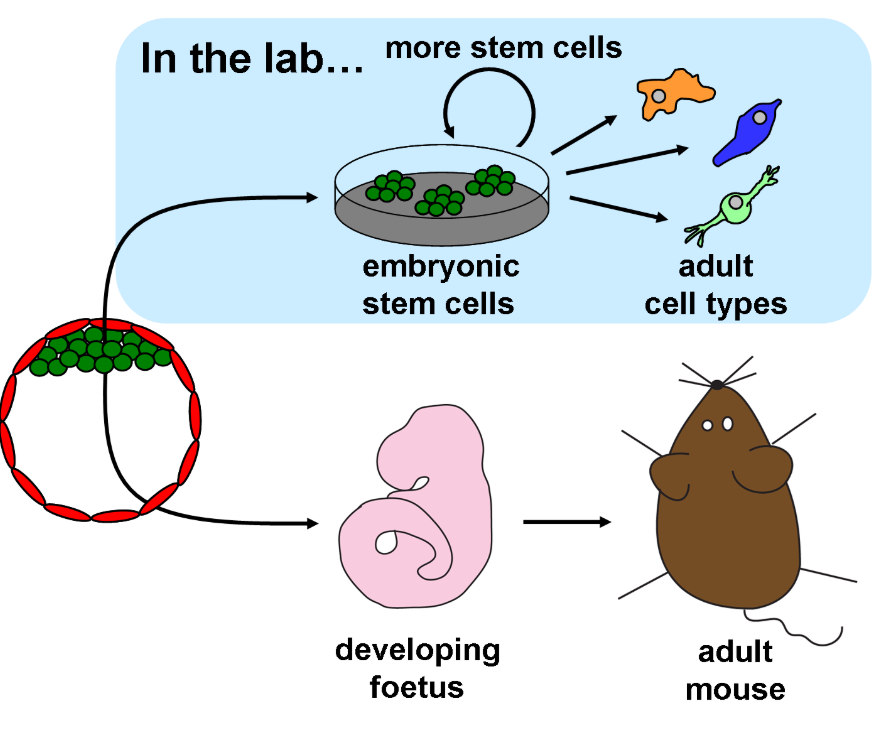What Are Embryonic Stem cells?
Stem cells have the unique ability to change into other types of cells, offering exciting possibilities for future medical treatments. The most versatile type are embryonic stem cells (ESCs), which can self-renew and are pluripotent meaning they can change into any cell type. These cells are collected from 3–5-day-old embryo called a blastocyst.
Image: A basic diagram of embryonic stem cells https://www.eurogct.org/embryonic-stem-cells-where-do-they-come-and-what-can-they-do-0

What can these cells potentially be used for?
In many diseases damaged cells cannot replace themselves. For example, after a heart attack, the body cannot replace lost heart tissue. Therefore, there’s a wide range of potential uses including treatment of Alzheimer’s, blindness, deafness, lung disease and autoimmune diseases. A key example from Shufaro and Reubinoffs paper in 2004 is in the treatment of neurological diseases like Parkinson’s disease and multiple sclerosis, which may one day be cured by stem cells.

Stem cell treatments are not only a futuristic idea. In his book, Embryonic stem cells and the law: crafting a humane system of regulation, Joshua Weiser shares his experience with a reoccurring tumour in his leg. The removal left him with scar tissue causing him a lot of pain. Stem cells were injected to allow new tissue to grow, which was lifechanging for Joshua, relieving him of his pain.
The ethical debate

The prominent ethical issue of ESCs centres on when life begins, at conception, or later in development. The Catholic Church for example opposes research involving human embryonic stem cells. In a conference for the Centre for Stem cells and Regenerative Medicine, the Catholic Bishops stated that “we must protect life at all times”.

This statement from an interview with the president of the Harvard stem cell institute demonstrates the opposing view: “It is important to be clear about the embryo from which stem cells are extracted. It is not implanted and growing in a woman’s uterus. It is not a foetus. It has no recognizable human features or form. It is, rather, a blastocyst, a cluster of 180 to 200 cells, growing in a petri dish, barely visible to the naked eye.”. I believe the reason this debate is so divided is because once someone’s opinion has formed it cannot be changed and often no amount of evidence will alter this.
What are the laws?

As opinions of ESCs are so varied, the laws can be very different worldwide. The UK has one of the most permissive set of laws with the Human Fertilisation and Embryology Act (legislation.gov.uk, 2008), which allows research on fertility, contraception, gene and chromosomal abnormalities, and potential disease cures. On the other hand, some countries do not allow ESC research, for example Italy, which prohibited ESCs in 2009. A famous advocate for stem cell research was the Superman actor Christopher Reeve, who became quadriplegic after a horse-riding accident in 1995. The US was considering banning ESCs at the time and his inspiring work helped prevent this.
What Are The Alternatives?
To avoid ethical concerns, adult stem cells can be used, but these cells are limited as they cannot produce all cell types. In 2007 induced pluripotent stem cells (iPSC) were first discovered by Dr Shinya Yamanaka. This video shows how these cells are made and some of the ways they are used:
I believe whenever possible, alternatives should be prioritised. However, in cases where there are no other options, I personally believe ESCs should be used and are justified, as the potential scientific breakthroughs could save lives. That said, it is important to consider the differing beliefs and therefore ensure informed consent is gained from anyone donating embryos.
References
legislation.gov.uk (2008). Human Fertilisation and Embryology Act 2008. [online] Legislation.gov.uk. Available at: https://www.legislation.gov.uk/ukpga/2008/22/contents.
Shufaro, Y. and Reubinoff, B.E. (2004). Therapeutic applications of embryonic stem cells. Best Practice & Research Clinical Obstetrics & Gynaecology, 18(6), pp.909–927. doi:https://doi.org/10.1016/j.bpobgyn.2004.07.002.
The is a good, well-researched blog. It clearly explore different viewpoints on a very sensitive issue. It is well-structured and easy to follow. It could benefit from more reflection. Currently it is very much stating the facts. Try to include some of your own thoughts and feelings throughout as though you are having a discussion with the reader.